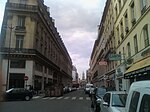Hôtel Guimard
19th century in Paris9th arrondissement of ParisBuildings and structures completed in 1772Former buildings and structures in ParisHôtels particuliers in Paris
The Hôtel Guimard was a private home located at 9 rue de la Chaussée-d'Antin in Paris, France. Commissioned by the Opera dancer Marie-Madeleine Guimard, it was designed by the architect Claude-Nicolas Ledoux in the neoclassical style, then built from 1770 to 1773. It is noted for having boasted its own 500-seat theater. The building was ultimately demolished as part of the massive urban renewal program headed by Baron Haussmann, which largely reshaped the city during the Second French Empire.
Excerpt from the Wikipedia article Hôtel Guimard (License: CC BY-SA 3.0, Authors).Hôtel Guimard
Rue Meyerbeer, Paris 9th Arrondissement (Paris)
Geographical coordinates (GPS) Address Nearby Places Show on map
Geographical coordinates (GPS)
| Latitude | Longitude |
|---|---|
| N 48.871658333333 ° | E 2.3335222222222 ° |
Address
Rue Meyerbeer 3
75009 Paris, 9th Arrondissement (Paris)
Ile-de-France, France
Open on Google Maps










